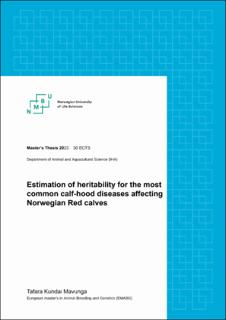| dc.description.abstract | Calf health has been gaining attention in the industry as it is the backbone of a successful dairy cattle enterprise. Calves that have been exposed to one or more calf diseases have been known to have compromised performance in later life. This study is the first to estimate heritability of Calf diarrhoea (CD), Joint disease (JD) alongside Respiratory diseases (RD) which has only been estimated once in 2008 in Norwegian Red calves. The main aim of the study was to estimate heritability for the most common calf diseases in the Norwegian Red calves.
The data consisted of 748 624 Norwegian Red calves from 3 437 herds in Norway from the period of 1 January 2014 to 31 December 2019. Records for treatments of the diseases before 180 days of age were 22 873 for respiratory disease, 8 410 for calf diarrhoea, 8116 for joint disease. The traits were defined as binary (0 = not treated, 1= treated). With the use of the three diseases a composite trait was created where each calf was scored based on being treated for any of the three diseases and the records amounted to 39 399. The data editing and descriptive statistics was done using RStudio version 2022.07.1.0 and genetic analyses were performed in DMU software. The estimated breeding values from 782 sires with progeny more than 200 were used to calculate correlation between the disease traits. The mean frequency of RD, CD and JD in the population were 3.05 %, 1.12 %, and 1.08% respectively. The overall calf disease frequency based on the most common diseases in the Norwegian Red population was 5.25 %.
The variance components and breeding values for the calf disease traits were estimated using a univariate linear animal model. Heritability of RD was 0.014 (0.0011), respiratory disease is the highest frequent diseases in Norwegian calves. The estimate for CD was 0.002 (0.0004) and the disease is the second highest recorded frequent diseases in the Norwegian Red calves. Joint disease was the third highest frequent disease with heritability of 0.004 (0.0005). The correlations between the disease traits are approximations of genetic correlations, RD and CD had 0.16, RD and JD had 0.29 and JD and CD had -0.05 correlation. Calves born in months under winter and autumn had an increased risk of RD, CD and JD as compared to calves born in spring and summer. Larger group size had a tendency of increasing the risk of calves having respiratory, diarrhoea and joint diseases. Estimates were, however, not significantly different between group sizes for all disease traits. There was no significant difference between bull and heifer calves on RD, CD, JD, and the composite trait.
The Norwegian Red breed has been known for its excellent health status and this is also observed in calf diseases frequency reported in this study which is low compared to other calf diseases frequency reported in the European region and other regions in the world. The heritability obtained for all the three diseases RD, JD and CD are low hence there is not much room for genetic improvement. However, when heritability was first estimated in Norwegian Red calves for RD not many herds were participating in the calf health recording system, but now most herds participate, and the frequencies obtained are reliable to safely prove that the Norwegian Red calf health management is good. | |
